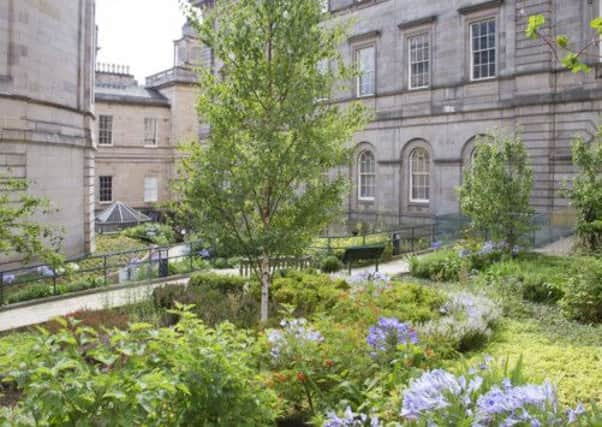Edinburgh’s hidden gem: the Archivist’s Garden


Almost deserted even at its September peak when it’s bright with blue ribbons of agapanthus, yellow St John’s Wort and the scarlet berries of rowan and viburnum opulus, this must be one of the capital’s best-kept secrets. Known as the Archivist’s Garden and formally opened just three years ago, this plant-packed space was designed and created by David Mitchell, curator of the RBGE. Entered through the courtyard gates of West Registrar Street or though General Registrar House – which anyone is welcome to do – the garden wraps around the back of the imposing Matheson Dome.
Drawing on his vast knowledge of plants Mitchell sought to highlight the information stored in the buildings collectively responsible for maintaining the records of the history and the memory of Scotland: bodies that also partner the Scotland’s People’s Centre for family history. A stated aim was to focus on ancient traditions and folklore before the knowledge of such customs and beliefs is lost forever.
Advertisement
Hide AdAdvertisement
Hide AdIain Ferguson, manager of Scotland’s People’s Centre and a key contributor to the BBC’s recent Gardeners’ Question Time broadcast which raised awareness of the existence of this garden, explains: “The planting scheme reflects Scottish collective memory in terms of folklore, birth, death, marriage, tartan, myth and heraldry.”
Pausing by one of the excellent information boards, Ferguson points out that each of the 57 different species of plants in the garden are connected to the National Records of Scotland. The scheme, he continues leading the way up the first of the wide paths that flow gently through the space, also reflects the relationship between certain plants and famous Scottish characters, such as Contorted Hazel, Corylus avellana, and Harry Lauder’s iconic walking stick.
As you walk up the slope it becomes increasingly obvious that the planting, a combination of colour, shape and texture, is laid out in bands. “The garden is planted in flowing patterns resembling the randomness of memory while replicating the different shapes on the surface of the human brain,” Ferguson says, adding – reassuringly – that this illustration of the randomness of brain activity stands in complete contrast to the orderly, highly organised record-filled buildings that surround it.
From the penultimate terrace you can decipher the workings of the brain; the nerve endings depicted in tapering plants. This is particularly well illustrated by the strong curves of Shuttlecock ferns highlighting the shape of the human brain and the randomness of thought.
Each plant, Ferguson points out, tells a story that resonates across the centuries. Rowan trees, for example, were traditionally planted to fend off witches and evil spirits: even nowadays foresters will avoid cutting down a rowan. “If you travel across a barren Highland landscape you will often see a single rowan left standing,” he says.
While white heather is well known for bringing good fortune into a house, less well known is the fact that it is associated with the Clan MacPherson. Heather was also used for thatching and is also associated with dyes for making tartan.
Low mounds of thrift or Sea pink, planted in a generous bed that wraps round the dome, is found in coastal areas. “It also features as the emblem on the badge of the Clan Hunter and was traditionally imprinted on the back of a 3d coin.”
A favourite with visitors is the fine Hazel tree with its contorted branches. “It’s called Harry Lauder’s Walking Stick after the late 19th century music-hall performer who used to appear on stage with a walking stick taken from the Hazel and sing songs like Roamin’ in the Gloamin’.” Hazel nuts, associated with fertility, were often distributed at weddings in the hope that people would have productive marriages.
Advertisement
Hide AdAdvertisement
Hide AdPerhaps the most important plant of all is the thistle. The national emblem of Scotland, late this year possibly on account of the cold spring and dry summer, thistles are at the heart of this garden. Represented in chivalry and the Order of the Thistle, tall, vertical stands draw your eye up towards the historic buildings.
Although originating from the Mediterranean, rosemary is represented for its wide use in culinary and medicinal fields. “In gardens where rosemary is planted and flourishes they say the woman is the boss,” Ferguson says, joking that he, “doesn’t have much rosemary in his garden.” Discovered by the 18th century Scottish plant collector Francis Masson, agapanthus recalls Scotland’s impressive history of plant collectors. The espaliered fruit trees on the top wall add a final intriguing dimension. Rosy red James Grieve apples are a reminder of the Lothian-based nursery man who bred this variety, while Worcester Pearmain were grown in the Clyde Valley. “Traditionally you planted an apple if you had a boy and a pear if you had a little girl,” Ferguson says, adding that it would be nice if that tradition continued today.
Despite the imposing nature of the buildings, the welcome extended is warm. “Visit the garden, have a cup of tea and do some research on your ancestors,” Ferguson says. “Or it’s the perfect place to take a break from your studies.”
• The Archivist’s Garden, HM General Register House, 2 Princes Street, Edinburgh EH1 3YY is open under Scotland’s Gardens today and tomorrow, 2pm-5pm. The café will be open for teas and volunteers will be on hand to impart the fascinating information that brings this garden alive. Otherwise the garden is open daily between 9am and 4:30pm. Enter through the courtyard gates on West Register Street (next to The Guildford Arms). Tel: 0131-535 1313, [email protected], www.scotlandspeoplehib.gov.uk